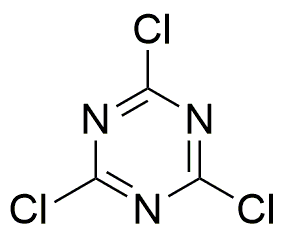Cyanuric chloride is widely utilized in research focused on:
- Water Treatment: It is used as a chlorinating agent in the production of disinfectants, helping to ensure safe drinking water by effectively eliminating harmful microorganisms.
- Pesticide Manufacturing: This compound serves as an intermediate in the synthesis of various herbicides and insecticides, enhancing agricultural productivity while minimizing environmental impact.
- Textile Industry: Cyanuric chloride is employed in the dyeing process, improving the fixation of dyes on fabrics, which results in vibrant colors and increased wash fastness.
- Pharmaceuticals: It acts as a building block in the synthesis of pharmaceutical compounds, facilitating the development of new medications with targeted therapeutic effects.
- Polymer Chemistry: This chemical is used in the production of specialty polymers, providing enhanced properties such as chemical resistance and thermal stability for various industrial applications.
General Information
Properties
Safety and Regulations
Applications
Cyanuric chloride is widely utilized in research focused on:
- Water Treatment: It is used as a chlorinating agent in the production of disinfectants, helping to ensure safe drinking water by effectively eliminating harmful microorganisms.
- Pesticide Manufacturing: This compound serves as an intermediate in the synthesis of various herbicides and insecticides, enhancing agricultural productivity while minimizing environmental impact.
- Textile Industry: Cyanuric chloride is employed in the dyeing process, improving the fixation of dyes on fabrics, which results in vibrant colors and increased wash fastness.
- Pharmaceuticals: It acts as a building block in the synthesis of pharmaceutical compounds, facilitating the development of new medications with targeted therapeutic effects.
- Polymer Chemistry: This chemical is used in the production of specialty polymers, providing enhanced properties such as chemical resistance and thermal stability for various industrial applications.
Documents
Safety Data Sheets (SDS)
The SDS provides comprehensive safety information on handling, storage, and disposal of the product.
Product Specification (PS)
The PS provides a comprehensive breakdown of the product’s properties, including chemical composition, physical state, purity, and storage requirements. It also details acceptable quality ranges and the product's intended applications.
Certificates of Analysis (COA)
Search for Certificates of Analysis (COA) by entering the products Lot Number. Lot and Batch Numbers can be found on a product’s label following the words ‘Lot’ or ‘Batch’.
Numéro de catalogue
Numéro de lot/série
Certificates Of Origin (COO)
This COO confirms the country where the product was manufactured, and also details the materials and components used in it and whether it is derived from natural, synthetic, or other specific sources. This certificate may be required for customs, trade, and regulatory compliance.
Numéro de catalogue
Numéro de lot/série
Safety Data Sheets (SDS)
The SDS provides comprehensive safety information on handling, storage, and disposal of the product.
DownloadProduct Specification (PS)
The PS provides a comprehensive breakdown of the product’s properties, including chemical composition, physical state, purity, and storage requirements. It also details acceptable quality ranges and the product's intended applications.
DownloadCertificates of Analysis (COA)
Search for Certificates of Analysis (COA) by entering the products Lot Number. Lot and Batch Numbers can be found on a product’s label following the words ‘Lot’ or ‘Batch’.
Numéro de catalogue
Numéro de lot/série
Certificates Of Origin (COO)
This COO confirms the country where the product was manufactured, and also details the materials and components used in it and whether it is derived from natural, synthetic, or other specific sources. This certificate may be required for customs, trade, and regulatory compliance.


